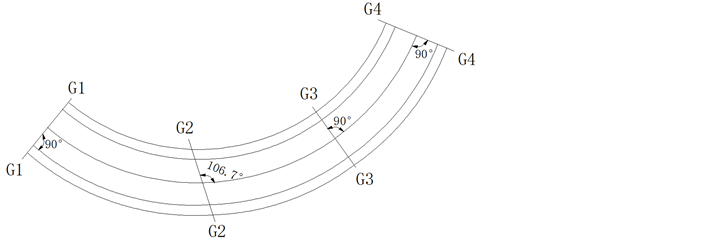1. 引言
近年来,我国城市建设飞速发展,为了适应新的城市的发展需求,弯箱梁桥被广泛应用于城市高架和立交桥中。弯箱梁桥造型优美,能较好地与周围环境结合在一起,满足景观需要;且能很好适应和改善道路线型,使交通线路的布置趋于合理和科学。由于城市建筑受周边环境约束,小半径弯箱梁桥越来越多的出现在城市桥梁建设中。
弯梁桥最主要的受力特点是:外荷载作用下,梁截面在发生竖向弯曲时,由于曲率的影响,必然产生扭转,而这种扭转作用又将导致挠曲变形,称为“弯扭耦合”作用 [1] 。由于弯箱梁桥中存在较大的扭矩,会使外侧超载,内侧卸载导致内、外侧支座受力不均,尤其对于小半径、宽跨比较大的弯箱梁桥来说,差异就更大了,因此有必要对小半径弯箱梁桥进行受力分析。
弯箱梁受力复杂,用一般的平面杆系分析方法进行计算,不能全面反映结构的受力特性及传力途径,故本文采用空间梁格法进行计算。梁格法是一种能较好地模拟原结构的空间结构分析方法,它具有基本概念清晰、易于理解和使用、计算费用低等特点,是一种实用的计算方法,在工程界得到广泛的应用。
梁格法 [2] [3] [4] 是借助计算机分析桥梁上部结构的一种有效适用方法。此法首先由莱特福(Liqhtfoot)和绍柯(Sawko)提出和使用,并经E.C.Hambly等的发展应用逐渐完善,适用于板式、梁板式、箱梁上部结构及各种组合体系桥梁。它是用一个等效梁格来代替上部结构,如图1所示。
梁格法的主要思路是将桥跨结构用一个等效的梁网格来简化,将分散在箱梁每个区域内弯曲刚度和抗扭刚度“凝聚”于最邻近的等效梁格内,即将实际结构的纵向刚度“凝聚”于纵向梁格内,而横向刚度则“凝聚”于横向梁格内。一般说来,等效梁格的网格越密,计算结果的精确度就越高 [5] 。根据大量的计算表明,利用梁格法分析结构完全能把握住结构的总体性能,对于设计而言,其计算结果也是足够精确的。然而由于实际弯桥与比拟梁格在某些局部性能上不可避免地存在着差异,梁格法的内力数据还需从实桥的受力性能出发进行整理与修正,才能作为实桥设计的依据。
 (a) 实际结构 (b) 等效结构
(a) 实际结构 (b) 等效结构
Figure 1. Equivalent grillage schematic diagram
图1. 等效梁格示意图
2. 影响弯箱梁桥受力的因素
2.1. 荷载因素
自重作用下,弯桥梁体因体积重心产生偏心不均布扭矩,其旋转方向总是朝着弧线外侧的,半径越小,扭转的趋势越明显。汽车荷载的偏心行驶及其行驶时的离心力,也会造成弯梁桥向外偏转并增大主梁扭矩。以及超载现象,也对弯桥受力有很大的影响。
2.2. 曲线半径和圆心角
在曲率半径相同时,弯梁桥的一联总长度越大,其弯曲程度就越大,因而圆心角比半径大小更能够全面地反映弯曲程度。圆心角越大,弯梁桥的受力特点就越趋向于弯桥的特性。当半径一定时,桥越宽,弯道上偏心行驶的汽车活载产生的内力越大,且比直梁桥要大得多。当桥宽一定时,半径越小,活载产生的内力越大。
2.3. 支承因素
1) 在一联连续梁两端的桥台或盖梁处采用两点或多点支承的支座,可有效地提高主梁的横向抗扭性能,保证其横向稳定性。
2) 中间墩的支承的合理选用应考虑其平面上的圆曲率半径、跨径及预应力效应的影响。
3) 弯梁桥的支承形式应根据曲率半径的大小、上下部结构的总体布置决定,选用对结构受力有利的支承方式,并由此决定全桥的力学计算图示,确定全桥的内力分布。
2.4. 预设支座偏心的影响
研究资料表明,支承偏心对弯桥恒载产生的扭矩影响最大,对活载和预应力产生的扭矩影响甚微 [6] 。因此,当弯梁桥仅两端具有较强的抗扭约束,而中间各墩是没有抗扭约束的点铰式支座,就可以将各中间支座预设偏心,即将点铰式支座的中心沿半径方向往曲线外侧移动一较小距离(通常在几十厘米),从而大大降低梁端的内扭矩及支座反力不平衡,使结构在恒载作用下处于一种相对平衡的状态。
降低弯梁内扭矩的最大值,可以充分利用混凝土截面提供的抗扭强度,节约抗扭钢筋的数量,同时桥台受到的扭矩也减小,桥台及支座的设计可以简化。因此,预设支座偏心是一种不需要增加任何投资而达到改善内力、节约材料目的的好办法 [7] 。
3. 工程实例与计算分析
本文以长沙市一处高架匝道桥为实例进行计算分析。该桥为三跨小半径钢筋混凝土弯箱梁桥,全长54.141 m,其跨径布置为(20.5 + 17.349 + 16.292) m。箱梁中轴线平曲线半径为28.75 m,桥宽8 m,箱梁平面布置如图2所示。其中G1、G3、G4号桥墩轴线与弯梁桥中轴线垂直,G2号桥墩轴线与弯梁桥斜交,斜交角度为106.7˚。
上部结构采用混凝土箱梁,单箱双室,箱梁高180 cm,箱梁顶宽800 cm,箱梁底宽440 cm。跨中截面如图3所示。
3.1. 有限元模型的建立
采用MIDAS/Civil软件建立全桥梁格模型,主桥共划分为五片纵向梁格(1#~5#):1#、5#为虚拟纵向梁格,2#~4#为主梁梁格。梁格模型如图4所示。纵向梁格节点间辅以虚拟横向梁格传递作用力。
纵向梁格划分如图5所示。
节点支撑位置如图6所示。
经试算:支座布置为G1#墩上支座外偏心0.8 m,G2#墩上支座外偏心0.3 m,G3#墩上支座外偏心0.3 m,G4#墩上支座外偏心0.9 m。

Figure 2. Planar layout of small radius curved concrete box girder bridge
图2. 小半径钢筋混凝土弯箱梁桥平面布置图

Figure 3. Cross section of midspan (unit: cm)
图3. 跨中横断面示意图(单位:cm)

Figure 5. The division of longitudinal cross section
图5. 纵向梁格划分
3.2. 计算结果与分析
在恒载作用下,弯箱梁竖向位移最大值为3.3 mm,如图7所示。
在城-A级荷载最不利情况下,弯箱梁竖向位移最大值为2.2 mm,如图8所示。
在支座不均匀沉降5 mm作用下,弯箱梁竖向位移最大值为9.5 mm,如图9所示。
在温度荷载作用下,弯箱梁竖向位移最大值为0.6 mm,如图10所示。
在恒载、车道荷载、不均匀沉降、温度荷载作用下,弯箱梁位移最大截面A、B、C三点位移如表1

Figure 7. The vertical displacement of constant load
图7. 恒载作用下竖向位移

Figure 8. The vertical displacement of land load
图8. 车道荷载作用下竖向位移

Figure 9. The vertical displacement of uneven settlement
图9. 不均匀沉降作用下竖向位移

Figure 10. The vertical displacement of temperature
图10. 温度作用下竖向位移

Table 1. Radius of small radius curved box girder (to be down, unit:mm)
表1. 小半径弯箱梁挠度(以向下为正,单位为mm)
表2. 支座反力汇总表
所示(表中A、B、C点位置见图3,A位于曲线内侧,C位于曲线外侧)。
从表1可以看出,在荷载作用下弯箱梁同一截面内、外侧挠度不一样,弯箱梁发生了扭转,这正是弯扭耦合效应引起的。这种效应在不均匀沉降作用下表现的最为明显,截面内、外侧最大偏差为14.87 mm。
在各种荷载组合下,支座反力的计算结果见表2。本桥考虑四种组合工况:
组合一:恒载 + 全桥满布车道荷载;
组合二:恒载 + 外侧单车道偏载;
组合三:恒载 + 内、外侧各半车道;
组合四:恒载 + 内侧单车道偏载。
从表2可以看出:由于弯箱梁存在弯扭耦合效应,桥梁内、外侧支座反力出现了不均匀现象,其中桥台处支座内外侧反力不均匀现象最明显,原因是梁端支座对弯箱梁扭转的约束贡献最大。通过在支座处设置预偏心则可减轻弯箱梁内、外侧支座反力不均匀的情况,随着偏心距增大,梁端内、外侧支座反力有平衡的趋势,对中间墩的支座反力影响较小。
4. 结论
本文基于弯梁桥其不可忽视的空间效应和弯扭耦合问题,以小半径弯箱梁作为研究对象,依据梁格法理论,采用MIDAS/Civil软件,对一座三跨小半径混凝土弯箱梁桥进行了空间分析,以减少采用传统简化方法计算时因自由扭转假设、边界条件假设及横向尺寸效应假设等所引起的失真,从而对其空间受力特性进行更为可靠的研究,研究其在不同荷载作用之下的结构位移、支座反力,可得出以下结论:
1) 小半径弯箱梁桥对周围地形适应性高,外形美观,受力满足要求,作为城市立体交通中的匝道桥,体现了桥梁设计“美观、安全、适用”的理念。
2) 在不同荷载的作用下,同一截面内外侧挠度最大偏差达14.87 mm,弯箱梁发生了扭转,这表明小半径混凝土弯箱梁结构存在明显的弯扭耦合效应,可引起箱梁截面的扭转。
3) 在四种工况作用下,桥梁内外侧支座反力最大差值为2008.4 KN,表明弯箱梁的弯扭耦合作用会引起支座反力不均匀的现象。
4) 支座偏心距对桥两端支反力影响较大,随着偏心距增大,梁端内、外侧支座反力有平衡的趋势,对中间墩的支座反力影响较小。